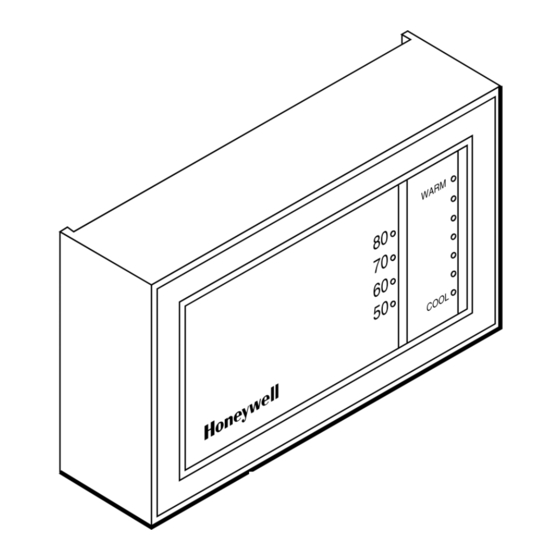
Table of Contents
Advertisement
Quick Links
The VVT and VVT-HC Thermostats provide spdt outputs
to control floating actuators in applications such as variable
air volume (VAV) terminal units.
—VVT (T641A): standard spdt floating control
thermostat.
—VVT-HC (T641C): provides manual heat/cool
changeover switch.
FLOATING CONTROL
The control provided by the thermostat is conventionally
called floating control. During floating control, a variation of
two-position control, the thermostat provides a three output
control, which is Advance motor, Reverse motor, and Hold.
On a change in temperature, the thermostat drives the
actuator to an intermediate position and then opens the circuit
to the actuator. The actuator remains in this position until
there is a temperature change at the thermostat. The actuator
is said to float between the limits of the thermostat to satisfy
various load requirements.
VAV SYSTEMS
VAV systems control the temperature within a space by
varying the volume of supply air. Air is delivered to the space
at a fixed temperature. The volume of supply air is controlled
by the space thermostat modulating the supply air damper.
When full heating and cooling flexibility is required in a zone,
it is handled by perimeter heating, or reheat capability in the
air terminal units. As individual zones shut down, the total air
flow in the system is regulated by a central duct static pressure
controller. The fan system is sized to handle an average peak
load, not the sum of the individual peaks. Because each zone
peaks at a different time of day, extra air is borrowed from the
off-peak zones. This transfer from low-load to high-load
zones occurs only in true VAV systems.
Pressure dependent systems do not incorporate an indi-
vidual zone air flow sensor and depend on a stable system
pressure to maintain flow. These systems require slower
motors such as the seven minute dampers, which are typically
controlled by the VVT (T641A) or VVT-HC (T641C) Ther-
mostats.
VVT, VVT-HC (T641A,C)
Floating Control Thermostats
Installation Instructions for the Trained Service Technician.
Application
Operation
HEAT ANTICIPATION/COOL ANTICIPATION
Control of heating or cooling units with a thermostat does
not allow for the temperature to remain exactly at the thermo-
stat set point, but varies within a certain temperature range.
Anticipation is added to the thermostat to reduce
this range.
The anticipator is a small resistive heater in the thermostat
that heats when the system is on or off. The heat produced by
the anticipator raises the internal bimetal temperature slightly
faster than the surrounding room temperature. The thermo-
stat anticipates the need to shut off the heating system sooner
than it would if affected by room temperature only. The VVT
(T641A) or VVT-HC (T641C) have fixed or voltage antici-
pation.
WHEN INSTALLING THIS PRODUCT...
1. Read these instructions carefully. Failure to follow
them could cause a hazardous condition.
2. Check the ratings given in the instructions and on
the product to make sure the product is suitable for your
application.
3. Installer must be a trained experienced service
technician.
4. After installation is complete, check out product op-
eration as provided in these instructions.
CAUTION
!
1. Disconnect power supply to prevent electrical
shock or equipment damage.
2. To prevent interference with the thermostat link-
age, keep wire length to a minimum and run
wires as close as possible to the subbase.
3. Do not overtighten thermostat captive mounting
screws, because damage to subbase threads can
result.
4. Do not short across coil terminals on relay. This
can
anticipator.
IMPORTANT: An incorrectly leveled thermostat will cause
the temperature control to deviate from set point. It is
not a calibration problem.
J. H. • 7-92 • © Honeywell Inc. 1992 • Form Number 69-0726
Installation
burn
out
the
thermostat
heat
Advertisement
Table of Contents

Subscribe to Our Youtube Channel
Summary of Contents for Honeywell VVT
- Page 1 VVT (T641A) or VVT-HC (T641C) Ther- mostats. IMPORTANT: An incorrectly leveled thermostat will cause the temperature control to deviate from set point. It is not a calibration problem. J. H. • 7-92 • © Honeywell Inc. 1992 • Form Number 69-0726...
- Page 2 The thermostat utilizes a four-wire opera- Because the cooling anticipator operates con- tion, so an additional transformer common wire must be tinuously in the floating band, the VVT (T641A) present for correct wiring and operation. See Fig. 1 for and VVT-HC (T641C) Thermostats incorporate a functional schematic of thermostat.
- Page 3 Fig. 2—Thermostat components and leveling procedure. BACK OF VVT-HC (T641C) BACK OF VVT(T641A) MOUNTING HOLES (4) MOUNTING HOLES (4) FRONT OF THERMOSTAT (COVER REMOVED) WALLPLATE SPIRIT LEVEL INTERNAL MOUNTING SET POINT HOLES (4) LEVER HEATING CONTACT COOLING CONTACT M6110 Fig. 3—Mounting thermostat using accessory wallplate.
- Page 4 Fig. 4—Dampers used with VVT (T641A) and VVT-HC (T641C) Thermostats for Type B damper applications. Y terminal energizes counterclockwise (ccw) winding on call for cooling, driving motor open. VVT (T641A) VVT-HC (T641C) (HOT) (HOT) (OPEN) (CLOSED) VVO BD CDO-52 DAMPER...















Need help?
Do you have a question about the VVT and is the answer not in the manual?
Questions and answers